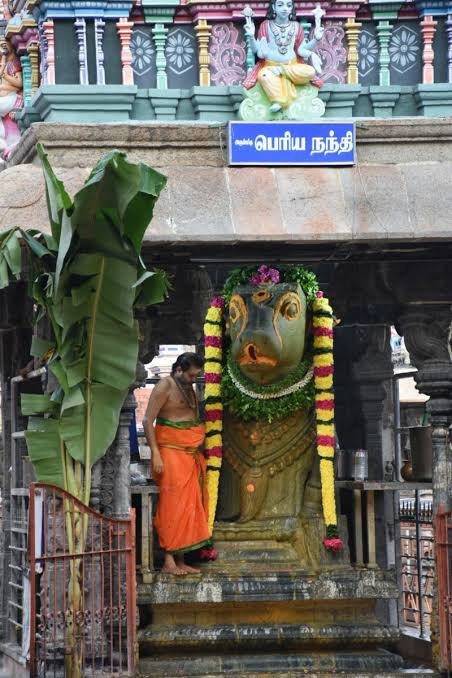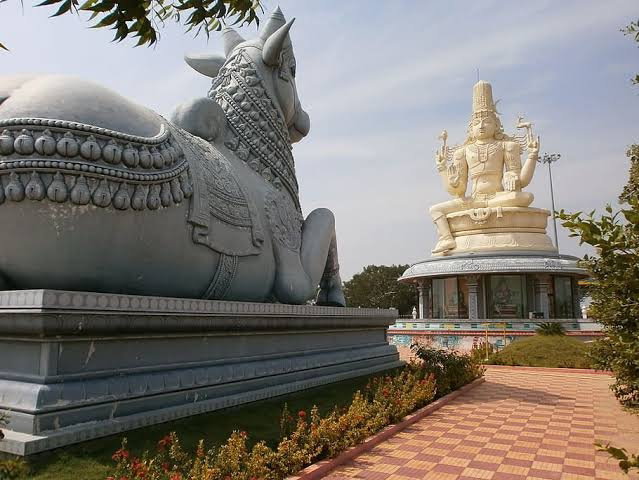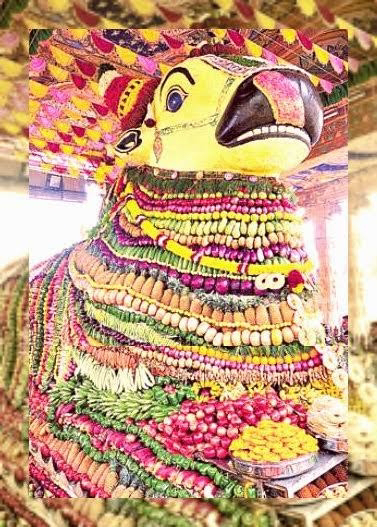NANDIKESHWARAR means happiness, joy, and satisfaction. He is also the guardian deity of Kailash, the abode of Shiva.
Almost all Shiva temples display stone images of a seated humped, white Nandi, reclining on a raised platform generally facing the main shrine continuously staring at the god. Nandi is one of Shiva’s chief attendants, occasionally depicted in sculpture as a bull-headed figure.
Nandi got the divine knowledge of Agamic and Tantric wisdom taught by Shiva, from the Parvati devi.
He is considered the chief guru of eight disciples of Nandinatha Sampradaya, namely
Sanaka,
Sanatana,
Sanandana,
Sanatkumara,
Tirumular,
Vyagrapada,
Patanjali, and
Sivayoga Muni.
These eight disciples were sent in eight different directions of the world by Nandi, to spread this knowledge.
SIGNIFICANCE :
In the temple, we always see Nandi sitting and glaring attentively in front of the Shiva linga.
The Truth is that just as Lingam is the symbol of the Almighty Supreme Shiva, Nandi (Bull) is the symbol of Jeeva (Individual Soul).
Nandi sitting before Shiva Linga signifies that a human being should turn away from Prakruthi and direct all his attention toward God only, that the jiva should always be focused on the Parameshwara.
The bull is a symbol of stability sitting on four legs, representing
Sathya (Truth),
Dharma (Righteousness),
Shanti (peace) and
Prema (Love).
It is only through these four that Mukti or Enlightenment can be attained and the soul could finally merge into the Supreme Soul. This is the purpose and the goal of human birth.
Nandi signifies and conveys the meaning that the purpose of life is to realize the oneness of all creation and one's identity with the Divinity.
1. Suggests seeing God in everything and loving every creation of God.
2. The goal of life is God-realisation.
3. To achieve divine Consciousness is the aim of life.
4. Nandi also symbolizes that no one should stand between Shiva Linga and Nandi.
5. The purpose of a human being is to realize God and there should be no distraction in this process.
6. In life's journey, human beings generally get distracted. One should have perfect control of Gyan-Indriyas and Karm-Indriyas.
7. The white color of Nandi bull symbolizes purity and justice.
8. From the yogic perspective, Nandi is the mind dedicated to Shiva, the absolute. In other words, to understand and absorb the light, experience, and wisdom is Nandi, which is the guru within Vahanas symbolize or complement the energy or character of their deity.
9. Nandi is also believed to promote fertility A youthful Nandi is shown licking his muzzle in an engaging gesture of rapt devotion to Shiva. Hindu gods are usually depicted as being sixteen years old (sixteen being four times four, a number signifying perfection). Nandi is always shown as a young bull, his horns not fully developed.
10. Nandi is a Brahman bull, the male zebu, or Indian ox. Brahman bulls have a hump on their back, horns, and a dewlap (a fold of loose skin hanging from the neck).
11. Nandi the bull is a deity conferred with many powers. He is the protector of Dharma and the chief of the team of Ganas, or attendants of the gods. In Hinduism, Nandi is considered as the chief of 18 Siddhas and therefore, the granter of boons.
Nandi statue is placed facing Shivalingam on the west side. A devotee should worships the Shivalingam standing by the side of the Nandi statue and facing the Shivalingam.
So, A simple Nandi Puja should be performed by bathing Him with Gangajal (Ganges Water), rinsing with perfume, wiping dry, and applying sandalwood paste, Offer incense and lamp.
As Nandi is loyal to Lord Shiva, once you chant ‘Om Namah Shivaya’, Nandi is bound to bless you too
Meditation :
1. He is in meditative form – simply sitting and waiting aptly.
2. Nandi is a symbol of eternal waiting.
3. He is not expecting Shiva to come out tomorrow or some other day.
4. He will wait forever.
5. That quality is the essence of receptiveness. And that is why Nandi is Shiva’s closest accomplice.
6. Before you go into a temple, you must have the quality of Nandi – to simply sit.
So, just by sitting here, he is telling you, “When you go in, don’t do your fanciful and bizarre acts. Don’t ask for this or that. Just go and sit like me.”
7. His waiting is a meditation – just sitting. 8. That’s his message for you. Simply go inside and sit. Alert, not sleepy.
9. Meditation means you are willing to just listen to the existence, to the ultimate nature of creation. You have nothing to say, you simply listen. That is the quality of Nandi – He is not sleepy or sitting passively. He is sitting very actively, full of alertness and life, but with no expectation or anticipation. That is meditation. Just waiting, not for anything in particular.
If you just wait without doing your own thing, your simple existence will do it. Once you are simply there, you become aware of the larger dimension of existence, which is always in action. You become aware that you are a part of it. But becoming aware that “I am a part of it” is meditativeness. Nandi is the symbolism of that. He reminds everyone, “You must sit like me.”
10. Waiting is considered the greatest virtue in Indian culture.
11. As a symbol of Shiva, the Nandi represents power, energy, vitality, joy, and delight, as well as a controlled potential for destructiveness.
12. When carved as a free-standing figure, the Nandi is always shown in a resting position that emphasizes the calmer aspect of its power.
13. The statue of Nandi is seen first. Nandi symbolizes the Aasan, which is, to be firmly seated in one place and posture.
Nandi gazes up at the murti of Lord Shiva. Similarly, the devotee should be perfectly still in an Aasan.
14. Nandi also symbolizes Dharma (Religion), underlining the fact that the goal of religion should be Shiva, i.e; salvation.
15. Nandi is described as the son of the sage Shilada. He underwent severe penance to have a boon– a child with immortality and blessings of Lord Shiva and received Nandi as his son. Legends say that Nandi was born from a Yajna performed by the Shilada. Nandi grew as an ardent devotee of Lord Shiva and he performed severe penance to become his gate-keeper, as well as his mount, on the banks of river Narmada, near Tripur Tirth Kshetra in present-day Nandikeshwar Temple, in Jabalpur, Madhya Pradesh.







Comments
Post a Comment